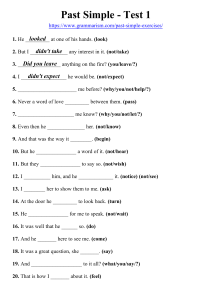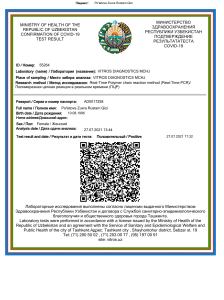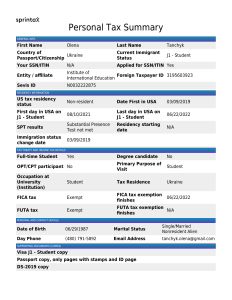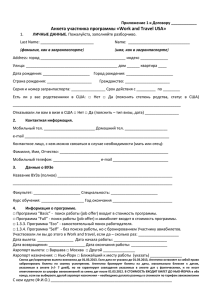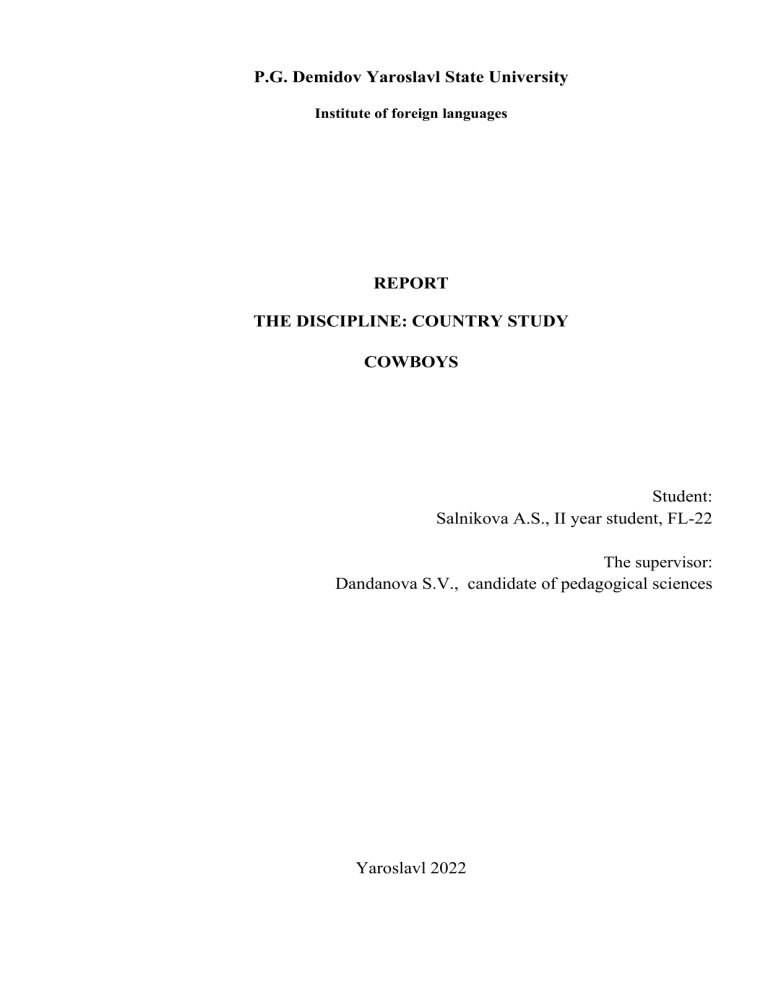
P.G. Demidov Yaroslavl State University Institute of foreign languages REPORT THE DISCIPLINE: COUNTRY STUDY COWBOYS Student: Salnikova A.S., II year student, FL-22 The supervisor: Dandanova S.V., candidate of pedagogical sciences Yaroslavl 2022 Contents Introduction…………………………………………………………….…..3 Chapter I. The origin of the cowboys………...………………………..…..4 Chapter II. The nationality and the social level of the cowboys………………………………...................................................................6 Chapter III. The life of the cowboys………………………….………....…8 Сonclusion..…………………………………………………………….....10 References…………………….……………………………………….….11 2 Introduction The relevance of the report is that the history of the cowboys is the great part of American history, the cultural heritage of the people who live in the USA. The cowboys are the iconic representation of America, an enduring symbol of the nation’s frontier and Westward expansion days. While it had been portrayed and often distorted in the movies and modern culture, cowboy history will always be an indelible part of America’s early days Purpose of work: it is studied the origin, the nationalities and the cultures of the cowboys in the USA Report aims: The first one is to highlight the origin of cowboys The second one is to get acquainted with the races, the nationalities and the social level of the cowboys The third one is to define the features of their lives The last one is to make a conclusion Object is the history of cowboys Subject is the origin, the traditions of cowboys and their daily life 3 Chapter I. The origin of the cowboys In 1519, shortly after the Spanish arrived in the Americas, they began to build ranches to raise cattle and other livestock. Horses were imported from Spain and put to work on the ranches. Mexico’s native cowboys were called vaqueros, which comes from the Spanish word vaca (cow). Vaqueros were hired by ranchers to tend to the livestock and were known for their superior roping, riding and herding skills[5]. By the early 1700s, ranching made its way to present-day Texas, New Mexico, Arizona and as far south as Argentina. When the California missions started in 1769, livestock practices were introduced to more areas in the West. During the early 1800s, many English-speaking settlers migrated to the West and adopted aspects of the vaquero culture, including their clothing style and cattle-driving methods. Cowboys came from diverse backgrounds and included AfricanAmericans, Native Americans, Mexicans and settlers from the eastern United States and Europe[3]. In the mid-1800s, the United States built railroads that reached further west, and cowboys played a central part in the nation’s “Manifest Destiny” as Westward expansion led to an ever-shifting frontier. Cowboys herded and rounded up livestock that were transported by rail around the country for sale. To distinguish what cattle belonged to which ranch, cowboys would brand the animals by burning a special mark into their hides. It took between eight and 12 cowboys to move 3,000 head of cattle along cattle drives[9]. 4 By the time the Civil War ended in 1865, the Union Army had largely used up the supply of beef in the North, increasing the demand for beef. The expansion of the meat-packing industry also encouraged consumption of beef. By 1866, millions of heads of longhorn cattle were rounded up and driven toward railroad depots. Cattle were sold to northern markets for as much as $40 per head[4]. Ranching continued to be widespread through the late 1800s. White settlers were permitted to claim public lands on the Great Plains as “open range” to raise purchased cattle. But by the 1890s, most of the land became privatized after feuds over land ownership were settled and the use of barbed wire became widespread. During the winter of 1886-1887, thousands of cattle died when temperatures reached well below freezing in parts of the West. Many scholars believe that this devastating winter was the beginning of the end for the cowboy era. Cattle drives continued, but on a smaller scale, up until the mid-1900s. Most cowboys gave up the open trail life and were hired by private ranch owners in the West[10]. 5 Chapter II. The nationality and the social level of the cowboys American cowboys were drawn from multiple sources. By the late 1860s, following the American Civil War and the expansion of the cattle industry, former soldiers from both the Union and Confederacy came west, seeking work, as did large numbers of restless white men in general. A significant number of AfricanAmerican freedmen also were drawn to cowboy life, in part because there was not quite as much discrimination in the west as in other areas of American society at the time. A significant number of Mexicans and American Indians already living in the region also worked as cowboys. Later, particularly after 1890, when American policy promoted "assimilation" of Indian people, some Indian boarding schools also taught ranching skills. Today, some Native Americans in the western United States own cattle and small ranches, and many are still employed as cowboys, especially on ranches located near Indian reservations. The "Indian Cowboy" is also part of the rodeo circuit[12]. Because cowboys ranked low in the social structure of the period, there are no firm figures on the actual proportion of various races. One writer states that cowboys were "of two classes—those recruited from Texas and other States on the eastern slope; and Mexicans, from the south-western region". Census records suggest that about 15% of all cowboys were of African-American ancestry— ranging from about 25% on the trail drives out of Texas, to very few in the northwest. Similarly, cowboys of Mexican descent also averaged about 15% of the total, but were more common in Texas and the southwest. Some estimates suggest that in the late 19th century, one out of every three cowboys was a Mexican vaquero, and 20% may have been African-American. Other estimates place the number of African-American cowboys as high as 25 percent[8]. Regardless of ethnicity, most cowboys came from lower social classes and the pay was poor. The average cowboy earned approximately a dollar a day, plus 6 food, and a bed in the bunkhouse, usually in a barracks-like building with a single open room[1]. 7 Chapter III. The life of the cowboys Most of the cowboy's life was spent working on the farm. It was rarely his own ranch—for the most part, the cowboy was a hired, often seasonal worker. Naturally, the range of functions performed by him included everything related to agriculture: grazing, sowing and harvesting, cultivating the land and other work. The cowboy's earnings were not the best. A decent salary could be considered 15-20 dollars a month. More profit could be earned during the haul. In winter, many cowboys worked on the ranch, while receiving shelter and food. Often they spent all the money they earned on drinking. Beer, not whiskey, was considered a popular drink[2]. Curiously, contrary to popular belief, most cowboys did not have their own weapons. A small salary was simply not enough even for the most ordinary revolver from the category of cheap. Good marksmen among the cattle breeders of the West were rather an exception to the rule. Cowboys occasionally developed a bad reputation for being lawless, and some were banned from certain establishments. They typically wore large hats with wide brims to protect them from the sun, boots to help them ride horses and bandanas to guard them from dust. Some wore chaps on the outsides of their trousers to protect their legs from sharp cactus needles and rocky terrain[11] When they lived on a ranch, cowboys shared a bunkhouse with each other. For entertainment, some sang songs, played the guitar or harmonica and wrote poetry. Cowboys were referred to as cowpokes, buckaroos, cowhands and cowpunchers. The most experienced cowboy was called the Segundo (Spanish for “second”) and rode squarely with the trail boss[2]. 8 Some cowboys tested their skills against one another by performing in rodeos—competitions that were based on the daily tasks of a cowboy. Rodeo activities included bull riding, calf roping, steer wrestling, bareback bronco riding and barrel racing. The first professional rodeo was held in Prescott, Arizona, in 1888. Since then, rodeos became—and continue to be—popular entertainment events in the United States, Mexico and elsewhere[6]. The code of cowboys deserves special attention. 1. When overtaking someone on the road, say hello. 2. Approaching someone from behind, greet him loudly before you get within pistol shot. 3. Don't wave to a man on a horse. This can scare the horse, and the person will think that you are an idiot (the correct greeting is a nod). 4. If you overtake someone on the road, don't look back. This indicates a lack of trust in a person. 5. Never shoot an unarmed man. Never shoot a woman at all. 6. The cowboy is pleasant to talk to, even if he is not in the spirit. Only weaklings complain, and cowboys hate weaklings. 7. Always be brave. Cowards are not tolerated in any form. 8. A cowboy always helps someone in need, even if it's a stranger or an enemy. 9. A horse thief can be hanged without hesitation. 10. Never try on someone else's hat [7]. 9 Conclusion The image of the cowboy is one that has been associated with American history for years. With the golden age rearing its head in 1866, the reign of the cowboy was strong in the country’s rural areas, bringing with it a whole range of legends and stories. The profession of a cowboy is still alive today. According to surveys, it is one of the five most dangerous occupations for men. And in the XXI century, on some ranches, horse shepherds still graze herds of cows, and in their leisure hours they demonstrate their prowess at rodeos. 10 References 1. Cowboys: Britannica: https://www.britannica.com/topic/cowboy (дата обращения: 16.05.2022) 2. Cowboys: https://www.history.com/topics/westward- expansion/cowboys (дата обращения: 16.05.2022) 3. Cowboy History: http://truecowboy.com/history.php (дата обращения: 10.05.2022) 4. Cowboy History: Were the Vaqueros America’s First Cowboys? https://www.cowboyactionshooting.com/cowboy-history-americas-firstcowboys/ (дата обращения: 10.05.2022) 5. Cowboys Without Guns: A Brief History Of The Real Wild West: https://historythings.com/cowboys-without-guns-brief-history-real-wildwest/ (дата обращения: 16.05.2022) 6. How the Cowboy Saddled Up and Rode Into American History: https://history.howstuffworks.com/american-history/cowboys.htm (дата обращения: 10.05.2022) 7. Price, B. Byron. Cowboys of the American West. San Diego, Calif.: Thunder Bay Books, 1996. 8. Rollins, Philip Ashton. The Cowboy: An Unconventional History of Civilization on the Old-Time Cattle Range. New York: Scribners, 1936. 9. Savage, William W., Jr., Cowboy Life: Reconstructing an American Myth. Norman: University of Oklahoma Press, 1975. 10.Savage, William W., Jr. The Cowboy Hero. Norman: University of Oklahoma Press, 1979. 11.What Was It Really Like To Be A Cowboy In The Wild West? https://www.ranker.com/list/life-of-a-wild-west-cowboy/melissa-sartore (дата обращения: 10.05.2022) 11 12.Cowboys: Wikipedia, the https://en.wikipedia.org/wiki/Cowboy#Culture 10.05.2022) 12 free (дата encyclopedia: обращения:
